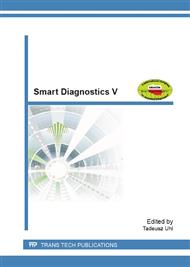[1]
K. E.-A. Van Den Abeele, P. A. Johnson, A. Sutin, Non-Linear Elastic Wave Spectroscopy (NEWS) Techniques to Discern Material Damage, Part I: Non-Linear Wave Modulation Spectroscopy (NWMS), Res. Nondestr. Eval.. 12 (2000) 17-30
DOI: 10.1007/s001640000002
Google Scholar
[2]
K.-Y. Jhang, Nonlinear Ultrasonic Techniques for Nondestructive Assessment of Micro Damage in Material: A Review, Int. J. Prec. Eng. Manuf. 10 (2009) 123-135
DOI: 10.1007/s12541-009-0019-y
Google Scholar
[3]
O. Buck, W. L. Morris, J. M. Richardson, Acoustic Harmonic Generation at Unbonded Interfaces and Fatigue Cracks, Appl. Phys. Lett. 33 (1978) 371-373
DOI: 10.1063/1.90399
Google Scholar
[4]
P. Duffor, M. Morbidini, P. Cawley, A study of the vibro-acoustic modulation technique for the detection of cracks in metals, J. Acoust. Soc. Am., 119 (2006) 1463-1475
DOI: 10.1121/1.2161429
Google Scholar
[5]
A. M. Sutin, V. E. Nazarov, Nonlinear Acoustic Methods of Crack Diagnostics, Radiographics and Quantum Electronics, 38 (1995) 109-120
DOI: 10.1007/bf01037881
Google Scholar
[6]
H. F. Hu, W. J. Staszewski, N. Q. Hu, R. B. Jenal, G. J. Qin, Crack detection using nonlinear acoustic and piezoceramic transducers – instantaneous amplitude and frequency analysis, Smart Mater. Struct. 19 (2010) 1-10
DOI: 10.1088/0964-1726/19/6/065017
Google Scholar
[7]
F. Aymerich, W. J. Staszewski, Experimental study of impact-damage detection in composite laminates using a cross-modulation vibro-acoustic technique, Struct. Health Monit. 9 (2010) 541-553
DOI: 10.1177/1475921710365433
Google Scholar
[8]
H.-C. Wu and K. Waenemuende, Mechanism Aspects of Non-linear Acoustic Signal Modulation due to Crack Damage, in T. Kundu, Advanced Ultrasonic Methods for Material and Structure Inspection, ISTE, London, 2010, pp.273-317
DOI: 10.1002/9780470612248.ch8
Google Scholar
[9]
K. Haller, Nonlinear acoustics applied to nondestructive testing, Printfabriken, Karlskrona, (2007)
Google Scholar
[10]
R. Carmona, W.-L. Hwang, B. Torresani, Practical Time-Frequency Analysis Gabor and Wavelet Transforms with an Implementation in S, Academic Press, New York, (1998)
Google Scholar
[11]
L. Cohen, Time-Frequency Analysis, Prentice Hall, Jew Jersey, (1995)
Google Scholar
[12]
B. Boashash, Time Frequency Signal Analysis and Processing A Comprehensive Reference, first ed., Elsevier Ltd., (2003)
Google Scholar
[13]
F. Hlawatsh, F. Auger, Time-Frequency Analysis: Concepts and methods, ISTE Ltd., (2008)
Google Scholar
[14]
N. E. Huang, W. Zhaohua, S. R. Long, K. C. Arnold, X. Chen, K. Blank, On Instantaneous Frequency, Adv. Adapt. Data Anal. 1 (2009) 177-229
DOI: 10.1142/s1793536909000096
Google Scholar
[15]
E. Kvedalen, Signal processing using the Teager Energy Operator and other nonlinear operators, Cand. Scient Thesis, University of Oslo, 2003 (http://folk.uio.no/eivindkv/ek-thesis-2003-05-12-final-2.pdf)
Google Scholar
[16]
M. F. Ghazadi, et al., Comparative study of instantaneous frequency based methods for leak detection in pipeline networks, Mech. Syst. Signal Process. (2011)
DOI: 10.1016/j.ymssp.2011.10.011
Google Scholar
[17]
M. Fieldman, Hilbert transform applications in mechanical vibration, first ed., John Wiley & Sons, (2011)
Google Scholar
[18]
G. Rilling, P. Flandrin, P. Goncalves, On Empirical Mode Decomposition and its algoritms, in Proceedings of IEEE-EURASIP Workshop on Nonlinear Signal and Image Processing/NSIP-03, Grado, Italy (2003)
Google Scholar
[19]
N. E. Huang, An adaptive data analysis method for nonlinear and nonstationary time series: the Empirical Mode Decomposition and Hilbert Spectral Analysis, in T. Qian, M. I. Vai, Y. Xu (Eds.), Wavelet analysis and applications, Birkhäuser Basel, Berlin, 2007, pp.363-376
DOI: 10.1007/978-3-7643-7778-6_25
Google Scholar
[20]
D. Donnelly, The Fast Fourier and Hilbert-Huang Transforms: A Comparison, Int. J. of Computers, Communications & Control 4 (2006) 45-52
DOI: 10.15837/ijccc.2006.4.2305
Google Scholar
[21]
N. E. Huang, Introduction to Hilbert-Huang transform and its related mathematical problems, in Ed. N. E. Huang, S. S. P. Shen (Eds.), The Hilbert-Huang transform and its applications, World Scientific Publishing Company, Singapore, 2005, pp.1-26
DOI: 10.1142/9789812703347_0001
Google Scholar
[22]
Y. Chen, M. Q. Feng, A technique to improve the empirical mode decomposition in the Hilbert-Huang transform, Earthq. Eng. Eng. Vib. 2 (2003) 75-85
DOI: 10.1007/bf02857540
Google Scholar


